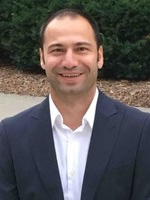RE@CSU
Mailing Address
Deparment of Mechanical Engineering
Fenn Hall Room 232
1960 East 24th Street
Cleveland, Ohio 44115
Campus Location
Fenn Hall Room 104
1960 East 24th Street
Phone: 216-687-6901
re@csuohio.edu
Meet Our Faculty Mentors
RE@CSU offers participants the opportunity to work alongside distinguished faculty whose research spans engineering, computer science, physical and occupational therapy, and exercise physiology. Each mentor leads projects that explore new frontiers in rehabilitation engineering and assistive technology, from wearable robotics and neural interfaces to motion analysis and regenerative medicine.
As part of the application process, students will be asked to indicate their top two faculty mentor preferences. We encourage applicants to review the project descriptions below to find areas that align with their interests and career goals.
Brian Davis

Modeling Biarticular Muscle Function for Rehabilitation Applications
Project Summary
Human movement relies on the precise coordination of multiple muscles, many of which cross more than one joint. These biarticular muscles play complex roles in generating and controlling motion. For example, the gastrocnemius can simultaneously influence both the knee and ankle joints, sometimes accelerating them in opposite directions. This project focuses on studying how biarticular muscles such as the biceps brachii and triceps brachii long head contribute to movement at the shoulder and elbow. Using ADAMS software for biomechanical modeling, the team will analyze how these muscles can produce motion patterns that may seem counterintuitive, deepening our understanding of upper-limb coordination.
REU Student Involvement
Students will use computer modeling and simulation to investigate joint biomechanics and muscle coordination. They will apply biomechanical principles to simulate arm movement and evaluate how electrical stimulation could improve motor control for individuals with spinal cord injuries. Through this experience, students will gain skills in musculoskeletal modeling, data interpretation, and rehabilitation research.
Kelle DeBoth Foust

PLAAY on the Move and OpenCap.ai
Project Summary
This project investigates how mobile over-ground harness systems can promote independent play and community participation among children with disabilities. Using OpenCap.ai, an open source markerless motion capture platform, researchers will collect and analyze kinematic data from children engaged in play within natural environments. This data will provide quantitative measures of movement patterns and physical engagement as indicators of participation quality. By synchronizing motion capture outputs with video-based event coding, the research team will examine how specific movement behaviors—such as reaching toward peers, orienting to play objects, and transitioning between locations—relate to play engagement and social interaction. This multimodal approach will contribute to developing objective, data-driven measures that can inform clinical interventions and assistive technology design.
REU Student Involvement
REU students will participate in the design and implementation of play-based data collection protocols, work directly with children using the mobility support systems, and process motion capture and video data for analysis. They will explore methods to synchronize datasets and identify links between movement behaviors and social participation outcomes. Through this experience, students will gain hands-on training in pediatric rehabilitation research, motion capture technology, data analysis, and human-centered research methods.
Debbie Espy

Project Summary
This project aims to identify biomechanical indicators of instability to support the development of more effective and clinically feasible balance-training interventions. Impaired balance limits safe, independent movement and increases fall risk, yet clinicians currently rely on observational or self-reported scales with no objective, instrumented measures of task intensity or instability. To address this gap, the research team analyzes full-body motion-capture data from individuals performing balance tasks of varying difficulty to determine how movement patterns shift as balance demands increase. The project also explores whether wearable sensors could serve as practical substitutes for full motion capture in clinical environments, improving access to data-driven balance assessment.
REU Student Involvement
REU students will help develop hypotheses about potential indicators of instability, analyze existing balance-task motion capture datasets, and assist in collecting pilot data from new participants performing targeted balance activities. Students will learn to process kinematic data, compare movement characteristics across different challenge levels, and evaluate whether wearable sensor signals align with full-body motion capture outputs. Through this experience, they will gain hands-on skills in biomechanics, data analysis, human movement science, and the development of clinically relevant measures for balance assessment and rehabilitation.
Apostolos Kalatzis

Cognitively Aware Assistive Robotics for Enhancing Human-Machine Collaboration and Rehabilitation
Project Summary
This project explores how adaptive, cognitively aware assistive robots can support individuals with disabilities in daily and rehabilitative tasks. By integrating context awareness, user interfaces, and physiological sensing, the team aims to develop systems that monitor and respond to users’ cognitive states in real time. These insights can guide robotic adaptations that improve safety, usability, and engagement while reducing mental workload. The research contributes to next-generation assistive technologies that enhance human-robot collaboration in rehabilitation settings.
REU Student Involvement:
The student will help design, implement, and evaluate adaptive control and user-interface mechanisms for assistive robots that respond to users’ cognitive states. They will collect and analyze multimodal data—including heart rate variability, eye-tracking, and task performance—to examine how system feedback shapes user workload. The student will also collaborate with clinicians and individuals with cognitive or motor impairments to inform design decisions and ensure the technology aligns with real rehabilitation needs.
Gina Kubec

Project Summary
This project aims to develop an artificial intelligence model that can translate first-person video into patterns of electrical stimulation that produce functional hand movements in individuals with paralysis. By combining wearable cameras with electromyography (EMG) collected from forearm muscles, the research team seeks to understand how visual information about intended actions relates to the muscle activation patterns required to perform them. Insights from this work will advance the design of next-generation neuroprosthetic systems that restore hand function through intelligent, context-aware stimulation.
REU Student Involvement
REU students will assist with collecting first-person video and EMG data from neuroprosthesis users at the MetroHealth Old Brooklyn Health Center, working closely with clinical and technical teams. Students will help prepare participants for data collection, process and organize multimodal datasets, and contribute to the development of AI models that map visual inputs to electrical stimulation commands. Through this experience, students will gain hands-on training in neuroprosthetics, human-subject research, EMG acquisition, machine learning foundations, and interdisciplinary clinical collaboration.
Liqun Ning

Project Summary
This project integrates mechanical and biomedical engineering to advance next-generation tissue constructs and biomedical systems that address key challenges in regenerative medicine and disease modeling. The research team specializes in advanced biomanufacturing techniques—including extrusion-based bioprinting, fused deposition modeling (FDM), stereolithography (SLA), and digital light processing (DLP)—and has extensive expertise in designing soft, hydrogel-based biomaterials.
These tools support collaborative projects across multiple institutions focused on peripheral nerve regeneration, modeling cancers such as glioblastoma and neuroblastoma, cardiovascular disease modeling, Fragile X syndrome modeling, and the fabrication of microgels for microbial delivery. The overarching aim is to develop innovative engineered tissues and platforms that improve our ability to study disease and support clinical translation.
REU Student Involvement
REU students will contribute to the design and fabrication of biomaterials and tissue-engineered constructs using state-of-the-art bioprinting and polymer processing techniques. They will prepare and characterize hydrogel systems, assist with experimental setups for disease modeling applications, and collaborate with multidisciplinary research partners. Students will gain hands-on experience in biomanufacturing, biomaterials development, and regenerative medicine research while building skills that prepare them for graduate studies and future careers in biomedical engineering.
Josiah Owusu-Danquah

Modeling and 3D Printing of Pneumatic vs. Shape Memory Artificial Muscles for Rehabilitation
Project Summary
This project investigates and compares two promising artificial muscle technologies for rehabilitation robotics: pneumatically driven soft actuators and shape memory alloy/polymer-based actuators. The goal is to understand how actuator type, material composition, and geometry influence motion, force output, and control precision for assisting impaired limb function. Building on NASA-supported work on functional coatings for SMAs, the project also explores how engineered surface layers improve bonding between SMAs and polymer matrices to enhance actuation efficiency and durability. Finite element (FE) simulations in ABAQUS will model the coupled thermo-mechanical and fluid–structure interactions in each actuator type, while additive manufacturing will be used to fabricate soft polymer structures and composite interfaces.
REU student involvement
Students will design actuator geometries, develop FE models to simulate actuation and stress distribution, and perform comparative analyses of pneumatic versus SMA-driven performance. They will also participate in 3D printing and experimental testing of soft actuators, collect strain and pressure data, and use simulation feedback to improve designs. Through this project, students will gain hands-on experience in computational mechanics, soft robotics, additive manufacturing, and human rehabilitation technologies.
Eric Schearer

AI Models for Hand Neuroprostheses
Project Summary
This project focuses on developing an artificial intelligence model that can translate first-person video into electrical stimulation patterns to activate functional hand movements in individuals with paralysis. By combining wearable video data with electromyography (EMG) recorded from the forearm, the research aims to create intuitive, vision-guided control strategies for neuroprosthetic systems. The ultimate goal is to improve independence and real-world usability for people with motor impairments.
REU Student Involvement
The REU student will assist in collecting first-person video and forearm electromyography data from participants, including individuals who use neuroprosthetic systems. They will work directly with both the clinical and technical teams at MetroHealth’s Old Brooklyn Health Center to support data collection sessions. The student will also help organize and prepare these multimodal datasets for AI model training and contribute to early testing of models that map video features to muscle stimulation patterns.
Prabaha Sikder

Project Summary
Research in the Sikder Lab focuses on developing advanced biomaterials and 3D bioprinting strategies to repair and regenerate musculoskeletal tissues, including bone and skeletal muscle. The team engineers “smart” scaffolds that convert mechanical motion into biological signals, promoting healing and restoring functional tissue performance. This work integrates principles from engineering, biology, and medicine to create next-generation regenerative technologies.
REU Student Involvement
The student will participate in hands-on research related to materials synthesis, 3D bioprinting, and cell culture. Working closely with the interdisciplinary team, the student will help design, fabricate, and test biomaterial scaffolds that support tissue regeneration. The experience will provide practical training at the interface of engineering and biological sciences while contributing to ongoing development of innovative regenerative medicine tools.
Metin Uz

Project Summary
Peripheral nerve injuries (PNI) affect millions worldwide and often result in long-term disability despite current treatment options. This project aims to develop a biodegradable, implantable platform that delivers custom MSC-derived exosomes (Exos) alongside wireless electrical stimulation (WES) to support nerve repair. Because Exos and WES may work synergistically to enhance regeneration, the platform enables both targeted Exos release and local stimulation of injured nerves. The work also explores how electrical stimulation influences Exos therapeutic content, with the goal of creating personalized treatments for a range of PNI conditions.
REU Student Involvement
The student will help develop and test the implantable platform, working with biomaterials, Exos preparation, and wireless stimulation systems. They will participate in experiments that assess Exos release, characterize the effects of electrical stimulation, and evaluate early indicators of nerve regeneration. This role provides hands-on experience at the intersection of biomaterials engineering and regenerative medicine while contributing to a promising new approach for PNI treatment.
Doug Wajda

Project Summary
This project investigates human performance in human-in-the-loop (HITL) systems, where people work with automated or semi-automated technologies to complete complex tasks. As automation expands in fields such as transportation, healthcare, and defense, it is critical to understand how human operators perceive, respond to, and influence these systems. The research examines how factors such as system design, autonomy level, and task complexity shape cognitive workload, decision-making, trust, and overall performance, with the goal of improving safety and efficiency in human-centered technologies.
REU Student Involvement
The student will assist in behavioral experiments and simulation studies that evaluate human performance under different operational conditions. Responsibilities include collecting and analyzing data related to cognitive workload, trust, and task accuracy, and working with tools such as neural haptics for sensory stimulation of the hand in a teleoperated bimanual robotics system. The student will collaborate with a multidisciplinary team of engineers, physiologists, phenomenologists, and ethicists while gaining hands-on experience in data collection, analysis, and research design.
Mailing Address
Deparment of Mechanical Engineering
Fenn Hall Room 232
1960 East 24th Street
Cleveland, Ohio 44115
Campus Location
Fenn Hall Room 104
1960 East 24th Street
Phone: 216-687-6901
re@csuohio.edu